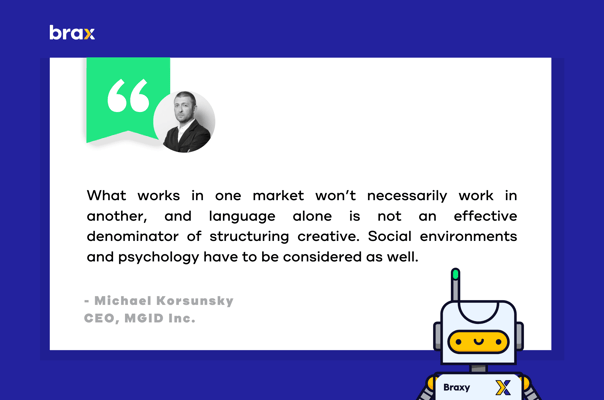As we move towards the second quarter of 2022, native advertising is expected to continue to grow in popularity. This form of advertising allows businesses to seamlessly integrate their products and services into the content of a website or other online platform.

When done correctly, this can be an effective way to reach target audiences without being intrusive or disruptive. However, as native advertising becomes more commonplace, it's important to learn how to best use this form of advertising in order to use your advertising budget wisely and, of course, to achieve better results.
To do this, experts in the field are offering your much-needed advice. Let's have a look at what the pros have to say.
Expert Advice on Ad Creative and Content Creation
If you're looking to create an effective native advertising campaign, it's important to start by creating high-quality ad creative and content. This will be the foundation of your campaign and can make or break your success.
But how exactly do you know if your ads and your landing page content are "high-quality"?
And how do you improve on that?
Here's what experts have to say:
“If Content is King, then Execution is the Castle"
The format you use to tell any given story should always be chosen to serve the story itself, since it's important to find the narrative first and then decide how to present it. If you do it the other way around, it will probably seem forced – like you’ve crammed your message into an envelope that’s not quite the right size.
Even in the word ‘storytelling’ itself... the story comes before the telling.”
-Graham McDonnell
VP of Brand and Creative, TIME
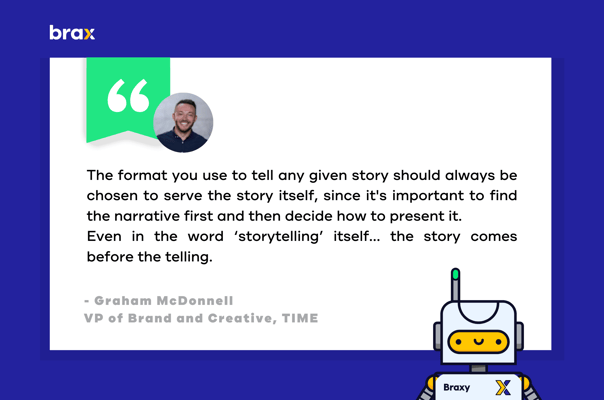
As we've mentioned over and over, people absolutely love stories. It's what helps them relate to something they are seeing or reading online. So before thinking about how to deliver the message, think about the story that leads up to the message.
There are different styles of storytelling that you can use in marketing, and they've all been pretty successful when it comes to connecting with the audience.
.jpg?width=604&name=Native%20Ads%20Article%20Brax%20(3).jpg)
“Proper localization is key to an effective native ad campaign."
What works in one market won’t necessarily work in another, and language alone is not an effective denominator of structuring creative. Social environments and psychology have to be considered as well.”
-Michael Korsunsky
CEO, MGID Inc.
"(Do)not blindly translate content from one language to another."
On branded content: As there are many languages spoken in India, we always advise our clients to not blindly translate content from one language to another, but to have cultural references to connect with the user. A saying in English if translated verbatim into a different language may lose its essence. Look for a local version to replace it with by understanding the context. While most understand English, speaking to the audiences in a language they primarily consume content in helps a lot.
This applies to the same language in a different region as well. UK English and cultural references for example will be different from those in the US.
-Deepak Karnani
Director, OneNative Advertising Pvt Ltd
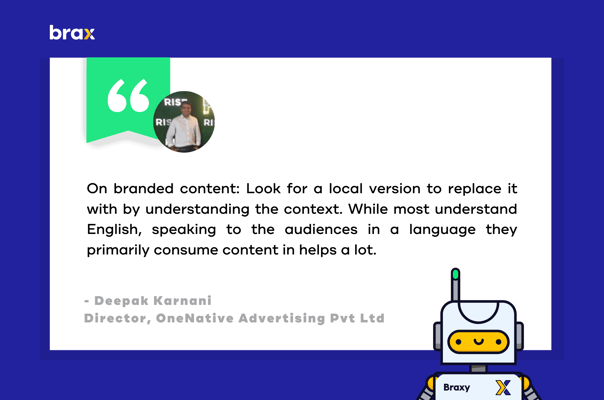
Localization is an important aspect when scaling campaigns. When trying to expand your ads to reach a wider market, you need to make sure that you connect with your audience properly.
This means taking cultural differences into account and using local references whenever possible.
If you skimp over localizing your ads, you will end up turning away customers instead of attracting them. In essence, it is a great way to reduce costs while still maintaining high levels of effectiveness.
By presenting users with content that is relevant to their interests and location, businesses can increase the likelihood that their message will be well-received. They can ensure that they are reaching the right audience with the right message.
Not only does this lead to higher rates of engagement, but it also helps to build trust between the advertiser and the consumer.
"Avoid a direct conversion-led approach up front."
Targeting audiences who have engaged with initial communication about the brand or solution with a more direct offer thereafter helps as there’s already a degree of awareness in place.
-Deepak Karnani
Director, OneNative Advertising Pvt Ltd
You need to work on warming up your customers first instead of forcing cold leads. This is why remarketing has one of the highest conversion rates of any online marketing tactic. It is one of the most important aspects of any online marketing campaign because you have already warmed a customer up before leading them towards your offer.
When you first approach a lead, they may not be ready to buy anything from you yet. They may need more time to consider your offer and do their own research.
That's why it's important to target them with relevant ads that will continue the conversation that you started earlier. This way, you're not bombarding them with too much information at once and you're giving them a chance to come back to you when they're ready.
Remarketing helps to nurture leads until they are finally ready to make a purchase. It also ensures that you're not wasting your resources on people who are not interested in what you have to offer.
Expert Advice on Choosing and Using Native Ad Platforms
Native ads have become a popular option in recent years, and for good reason: they offer many benefits that other types of ads don't such as a solution to ad blindness. But not all native ad platforms are created equal.

Here are some tips from experts on choosing and using native ad platforms:
"Component 1: The Right Platform"
There are many native ad networks to choose from, such as Taboola, Outbrain, and NativeAds. You want to make sure you select a system that works for your industry and will reach your target audience.”
CEO and Co-founder, TruleYours
"Have enough budget"
If you’re having a multi-platform approach, make sure you have budgets to do justice to every campaign being set up as there will be many variants (platforms, devices, ad copies, etc).
-Deepak Karnani
Director, OneNative Advertising Pvt Ltd
“Take Advantage of the UX & UI of the Native Environment"
Appearance matters, but it’s not enough just to mimic the look of native content. Create ads that make clever use of UX. Consider not just what the users see but what their immediate and long-term goals are when using the app.”
Creative Strategist, Liftoff
In summary, when choosing a platform to run native ads, you must:
- investigate the native ad networks' audience based on their publishing websites;
- prepare enough budget if you want to utilize several ad networks; and
- know the long-term goals of the audience you are targeting based on the websites or apps you are promoting in, within the platform of your choice.
Expert Advice on Campaign Creation
Advertisers need to do more than just create native advertising campaigns—they need to make sure those campaigns are effective. To achieve that, here are some insights from the pros in this space:
“An increasing focus on mobile"
As our devices shrink in size and our time spent on them increases, the focus of advertisers is shifting to mobile. Native advertising was interestingly developed to enhance the mobile browsing experience. Its scope, however, has been much wider, covering multiple formats, devices, and environments.
A Statista research from 2021 found that the number of mobile users worldwide is 7.1 billion. So, we can imagine how important a seamless mobile experience is. Large buttons/CTAs, overlapping text on the creatives, or difficult-to-scroll content will no longer cut it. Native ads have been evolving to be more agile and responsive to cater to mobile users in a better way.”
-Emilia Kirk
Global Head of Growth, Seedtag.com
Mobile advertising is an increasingly important focus for native advertising campaigns. As more people move away from desktop browsing and towards mobile devices, it's crucial to make sure your ads are formatted correctly for smaller screens.

You can benefit from responsive ads and website pages as these will adjust to the screen size of the device on which they are being viewed, ensuring that they look good and are easy to read on any screen size. Having responsive ads means that you don't have to worry about your ads looking bad or not being readable on smaller screens.
Advertisers also need to be aware of how people use their mobile devices—many people now use them as their primary source of information, so your ads need to be interesting and relevant enough to stand out in a sea of content.
"Setting up parallel campaigns with different settings to map the efficacy also helps."
-Deepak Karnani
Director, OneNative Advertising Pvt Ltd
Split-testing is a key part of any effective advertising campaign, and it's no different when it comes to native advertising. By testing different variations of your ads, you can see what works best and focus your efforts on those ads that are most successful.
You can test different headlines, images, or ad copy to see which variation generates the most clicks or conversions. You can also test different placements within articles to see which position generates the most clicks.
By running parallel campaigns with different settings, you can map the effectiveness of each variation and find out which ones work best for your target audience. This will help you to create more successful and effective native advertising campaigns.
Expert Advice on Campaign Optimization
When it comes to running a successful marketing campaign, there are a lot of moving parts. From choosing the right target audience to staying within budget, there's a lot to consider. However, one of the most important factors in any campaign is optimization.
Fortunately, there's plenty of expert advice out there on how to do just that in the ever-changing landscape of online advertising:
“The first step to successful optimization is what I call ‘KPI alignment'."
This means aligning your main campaign KPIs with your optimization efforts.
For example, on Taboola, a lot of native advertisers simply bid higher on the sites that are giving the highest conversion rate, regardless of campaign type and target KPI. That’s a good starting point to get decent results. In order to get great results consistently, you have to be more purposeful in your optimization.
So, where do you start improving?
First, see if the campaign you want to optimize is in scaling mode. If it is, it's in the best condition possible to be optimized. Secondly, identify what is the main KPI of the campaign you want to optimize. For cold traffic, it might be CPC, for warm retargeting cost per lead, and for hot retargeting ROAS.
Now that you have established the KPIs you’ll optimize against, define the minimum number of clicks or conversions a publisher needs to get to even be ready to optimize. You don't want to waste time trimming sites that have very little data and have almost no impact on performance.
Personally, I like to sort spend in descending order and only consider, for optimization purposes, placements that have at least 50 clicks in a certain period.
What you want to do next is exclude publishers with at least 50 clicks that don't meet your CPC, cost per lead, ROAS target, or whatever your KPI is. For those that meet your KPI target, you want to bid higher.
The further away your placement or site is, on the positive side of the scale, from your ideal KPI, the higher you can bid. I wouldn't recommend bidding more than 30% though. Remember that impressions also come into play here. Bidding higher on a site with 50,000 impressions will have a greater effect than bidding on one with only 2,000. The former will provide you with more scaling potential and opportunities.
- Pedro Campos
Founder, Advertongue
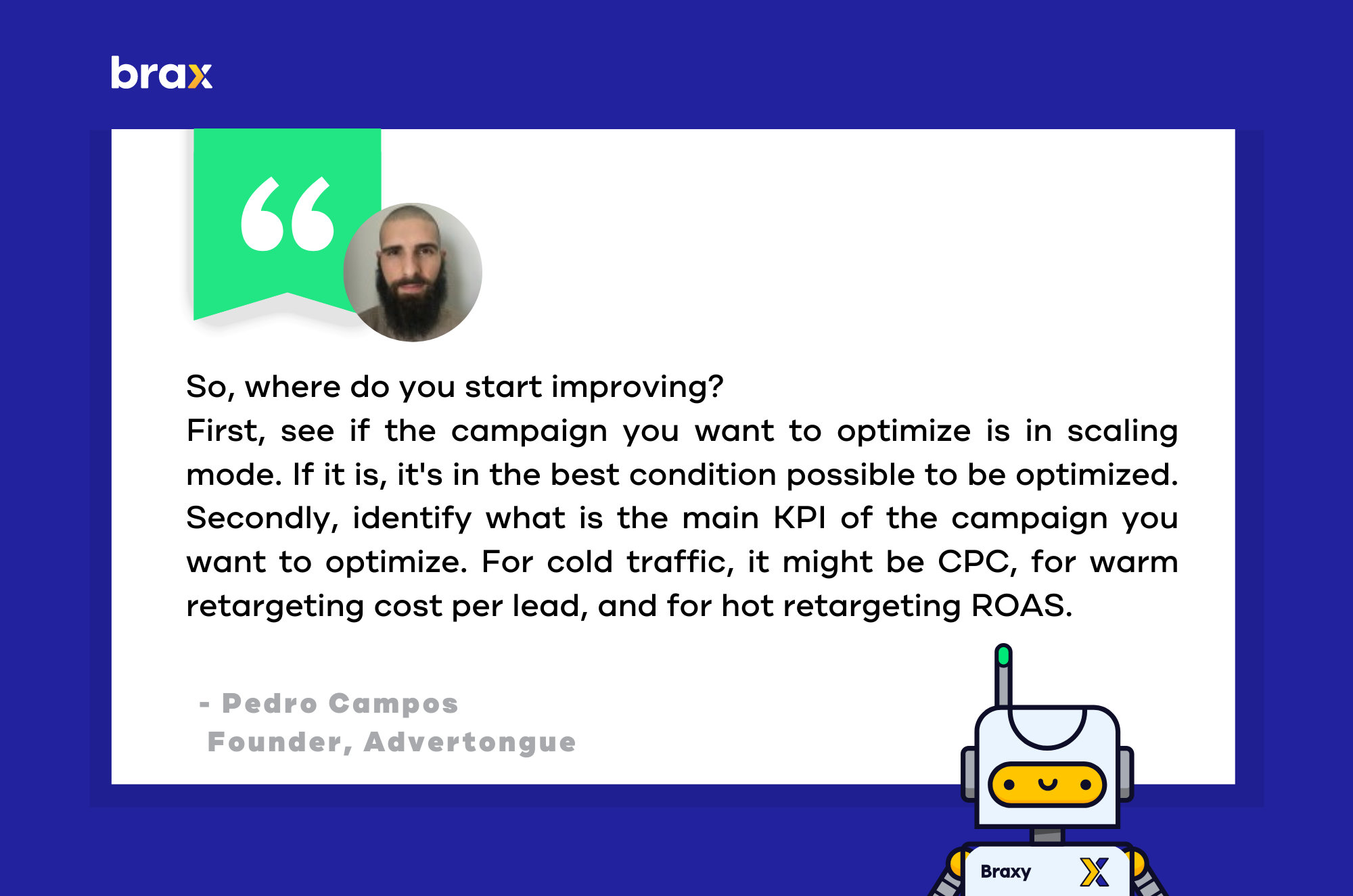
.jpg?width=610&name=Native%20Ads%20Article%20Brax%20(2).jpg)
You should align your main campaign KPIs with your optimization efforts, which means looking into the goals of the campaign for every step in the marketing funnel. As such, you should not expect to convert cold traffic into a customer right away; your first goal should be to attract them enough to click on your ad and learn more.
(Hint: KPIs are not always about purchases/subscriptions and ROI.)
"(Do) not try too many optimisation strategies upfront"
On content discovery: When it comes to content discovery and distribution, it helps to be patient and not try too many optimisation strategies upfront.
-Deepak Karnani
Director, OneNative Advertising Pvt Ltd
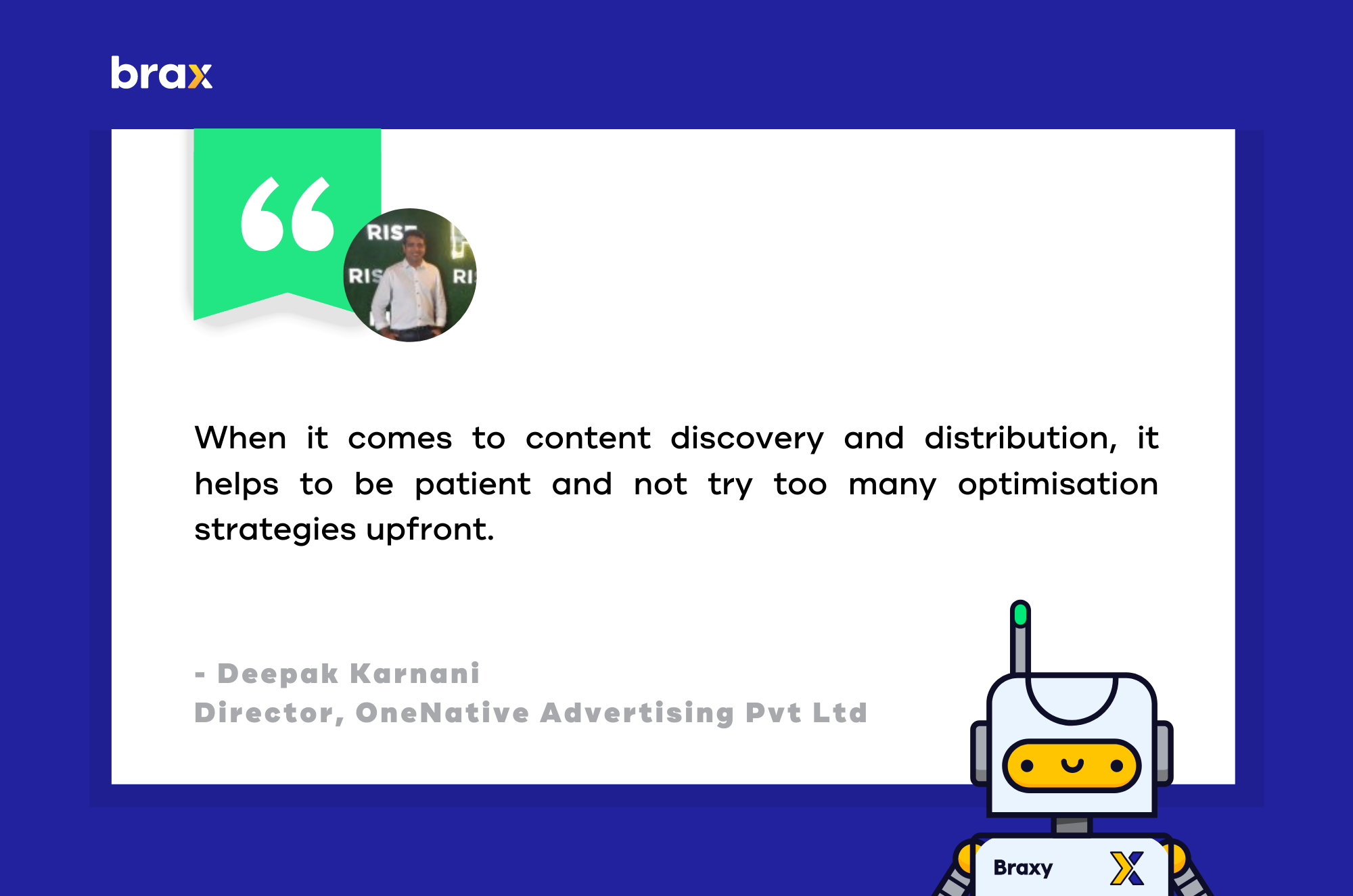
Sometimes, advertisers get too excited about the traffic they get or too worried about their budget that they end up optimizing too early in the process. Give your campaigns enough time to receive traffic and generate conversions before making adjustments to your native ads campaign.
"Optimize bids at the widget and site level"
As native advertising continues to expand its market share in the digital advertising space, the key to outperforming other advertisers on these networks is to optimize bids at the widget and site level. Brax is providing advertisers with a great way to do this at scale.”
-Kim Todaro
Senior Media Buyer, Brax.io
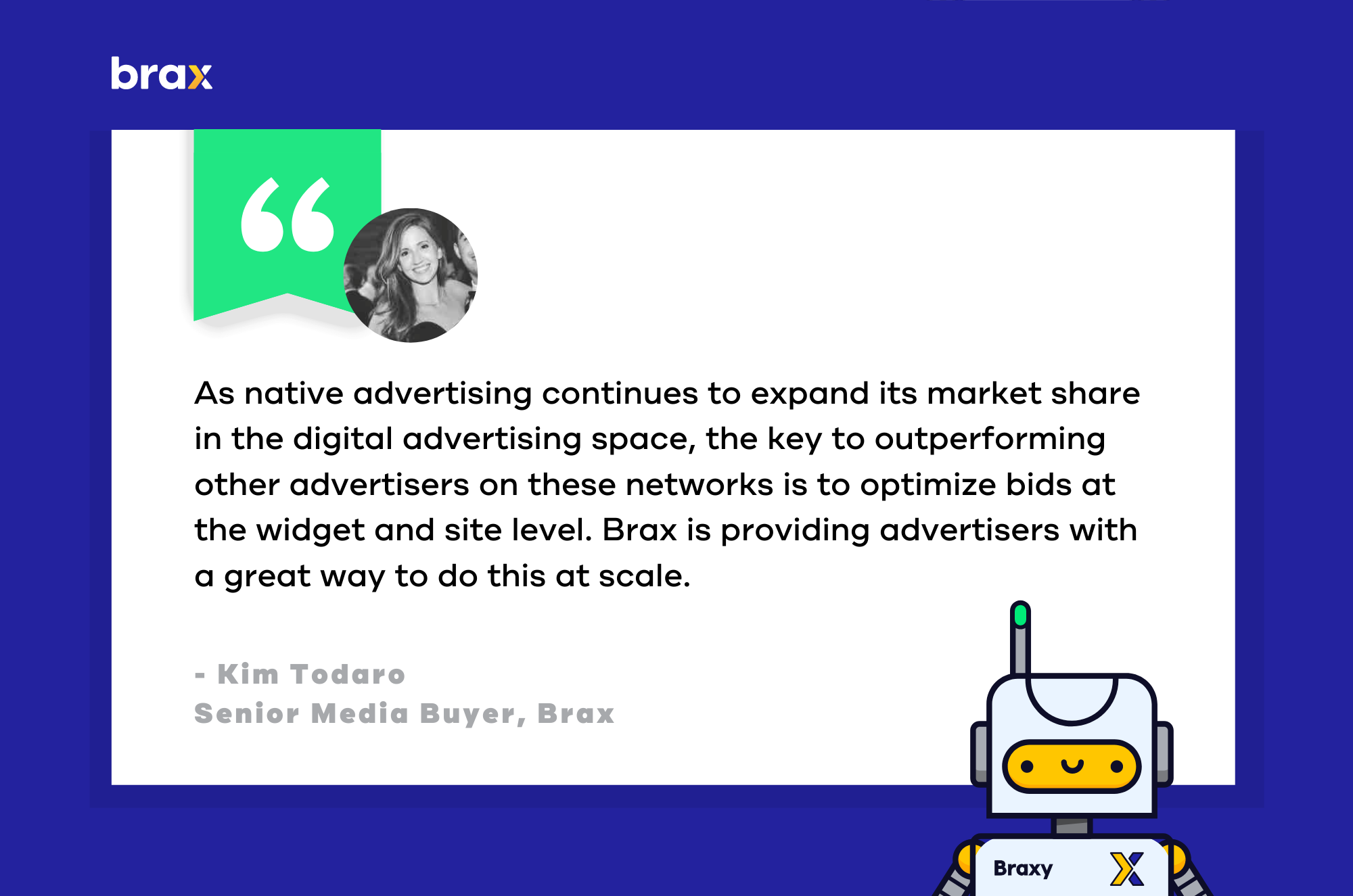
Once you've received enough traffic to warrant an optimization, take a look at the performance of the ads based on the widgets used and the sites it has been shown in. Again, as mentioned by Pedro Campos, you should keep your specific KPIs for that ad in mind when optimizing the campaign.
Expert Advice on Native Advertising Automation
Automation has made it possible for agencies and brands to scale their native ad campaigns with ease as you eliminate most of the grunt work related to digital advertising.
When it comes to automation, focus on automating the processes that will save you time rather than automate tasks that don't have a direct impact on your campaign's performance. For instance, automating bid management or optimization processes can help speed up the optimization process while still delivering accurate results.
There are different types of ad automation that you can utilize in this time and age. This includes:
- automation by automatic ad creation, configuration, and upload
- automation by campaign optimization.

Here's what our experts have to say on this topic:
"Scale by utilizing automation technologies (such as Brax)"
The most important thing I've seen this year is advertisers being able to scale by utilizing automation technologies (such as Brax). This allows them to focus on creatives and attribution rather than hidden bidding methods and time-consuming targeting tactics.
In this arena, cutting through the noise with unique content moves the needle when you don't have to worry about traffic quality and ways to manipulate attribution.
With automation, instead of managing dozens or hundreds of micro-budget ad sets, you end up consolidating everything in 1-5 campaigns with high budgets to help the algorithm gather data to determine the optimal audience.
-Stephanie Reed
Director of Demand, Revcontent
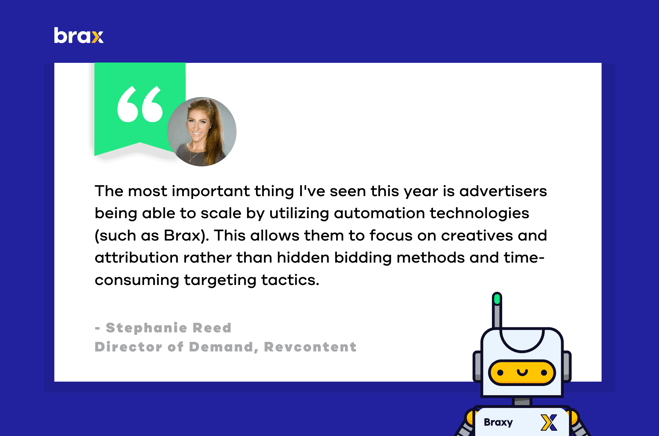
"Give back more hours in your day"
Optimization doesn't just happen at the site level, you also have ads, countries, regions, audiences, and more. All of this can be time-consuming, so consider using a tool to help you automate native optimization and give you back more hours in your day.”
-Pedro Campos
Founder, Advertongue
"Keep pace and distance yourself from competitors who are slow to adopt."
Never has it been more apparent than in 2022 how critical it is to have automation platforms -like Brax- help you push your native spend. There are simply too many variables for one media buyer or even a team to handle at great scale. Utilizing automation platforms will not only help you maximize every dollar you spend but allow you to keep pace and distance yourself from competitors who are slow to adopt.”
-Joe Burton
Founder, ROI Marketplace
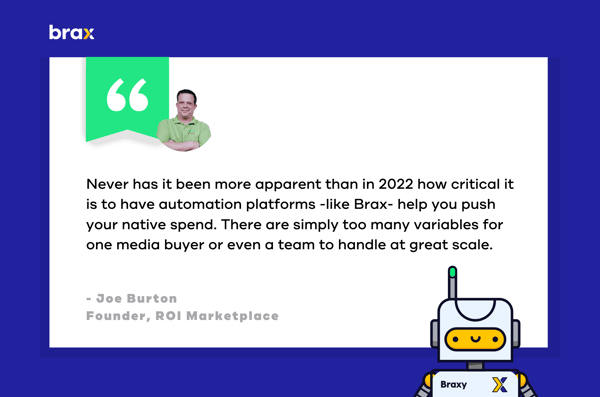
Brax's automatic optimization tool makes it easy to optimize your bids at the widget and site level, so you can get the most out of your campaign. With a tool like this, you can focus on creating great content and let our tool do the hard work of optimizing your bids for you.
You can create rules that Brax will automatically follow to ensure that you're getting the most out of your campaign while still obeying the optimization tactics you utilize when manually optimizing.
For example, you can set a rule that says "bid 10% more for clicks on widgets whose spend is less than $20 but conversion is greater than 1."
This will allow you to bid more aggressively for the traffic that you want and ensure that you're not wasting money on traffic that doesn't convert.
Final Thoughts
It's important to stay up to date on the latest trends in native advertising. Experts say that using unique content and utilizing automation platforms like Brax are essential for success in 2022.
As we can see, using automation is essential for scaling your native ad campaigns, for it can help you save time and lets you optimize your campaigns more efficiently. Advertisers who don't use automation may find themselves at a disadvantage in the coming years.
So make sure you're doing everything you can to stay ahead of the competition!
If you're not using a tool like Brax, then now is the time to start. Our platform makes it easy to get the most out of your native advertising campaigns and helps you optimize your bids at scale. Sign up for a free trial today and see the results for yourself.
